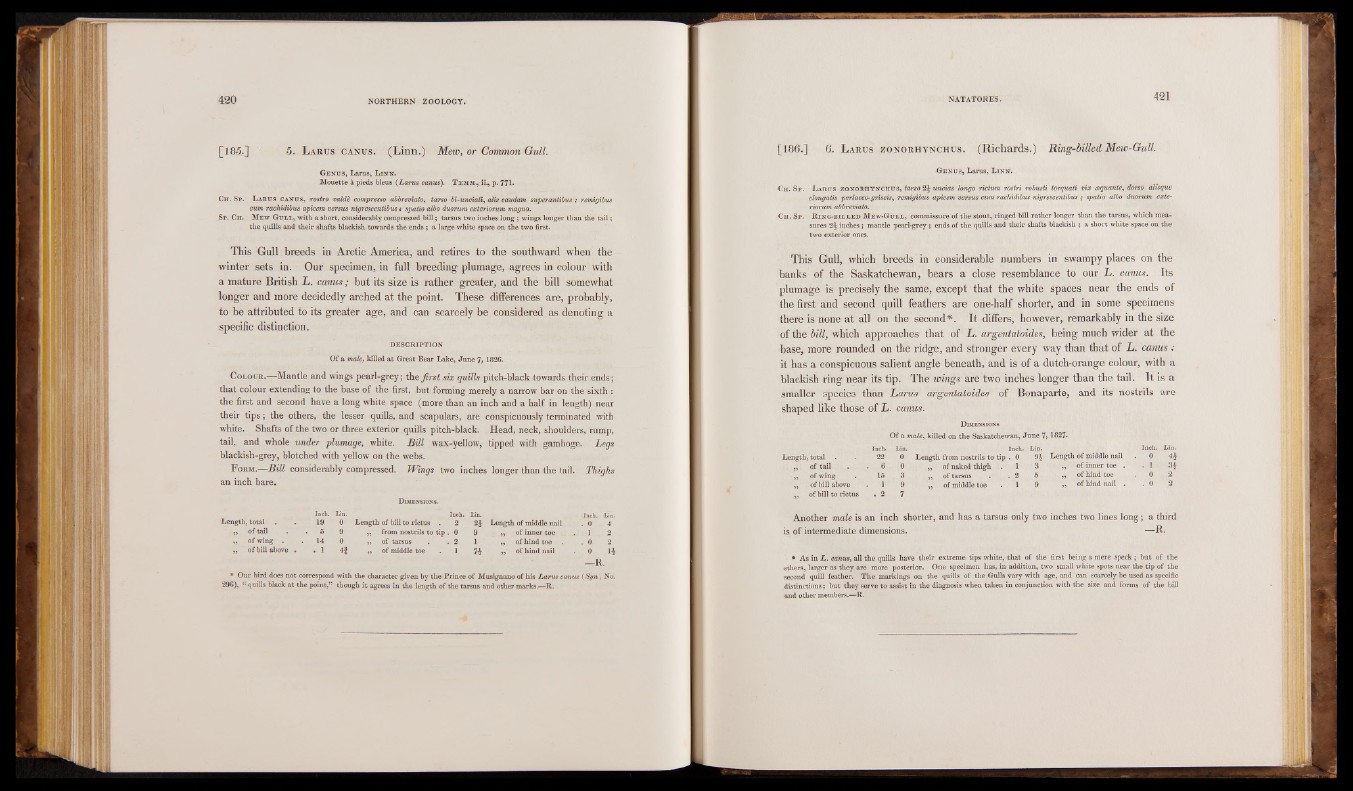
[185.] 5. L a r u s c a n u s . (Linn.) Mew, or Common Gull.
Ge n u s , Larus, L in n .
Mouette a pieds bleus {Larus canus). T em m ., ii^ p. 771-
Ch . Sp . L a rus canus, rostro vald& compresso abbreviate, tarso bi-unciali, alis caudam superantibus ; remigibus
cum rachidibus apicem versus nigrescentibus t spatio albo duorum exteriorum magno.
Sp . Ch . M ew Gu l l , w ith a short, considerably compressed bill; tarsus two inches lo n g ; wings longer than the ta il;
the quills and their shafts blackish towards the en d s; a large w hite space on the two first.
This Gull breeds in Arctic America, and retires to the southward when the
winter sets in. Our specimen, in full breeding plumage, agrees in colour with
a mature British L . cam s; but its size is rather greater, and the bill somewhat
longer and more decidedly arched at the point. These differences are, probably,
to be attributed Holts greater age, and can scarcely be considered as denoting a
specific distinction.
DESCRIPTION
Of a male, killed at Great Bear Lake, June 7, 1826.
C olour.— Mantle and wings pearl-grey; the first six quills pitch-black towards their ends;
that colour extending to the base of the first, but forming merely a narrow bar on the sixth :
the first and second have a long white space (more than an inch and a half in length) near
their tips; the others, the lesser quills, and scapulars, are conspicuously terminated with
white. Shafts of the two or three exterior quills pitch-black. Head, neck, shoulders, rump,
tail, and whole under plumage, white. Bill wax-yellow, tipped with gamboge. Legs
blackish-grey, blotched with yellow on the webs.
F orm.— Bill considerably compressed. Wings two inches longer than the tail. Thighs
an inch bare.
Dimensions.
Length, total . Inch. 19 0 Length of bill to rictus . 2 2* Length of middle nail . 0 4 „ of tail . 5 9 „ from nostrils to tip . 0 9 „ of inner toe 1 2 „ of wing . . 14 0 „ of tarsus . . 2 1 ,, of hind toe . 0 2 „ of bill above . . 1 4 | „ of middle toe . 1 7* „ of hind nail 0 14
— R .
* Our bird does not correspond with the character given by the Prince of Musignano of his Larus canus (Syn., No.
296), “ quills black at the point,” though it agrees in the length of the tarsus and other marks.—R.
[186.] 6. L a r u s z o n o r h y n c h u s . (Richards.) Ring-billed Mew-Gull.
Ge n u s , Larus, Lin n .
C h . Sp. L aru s zo n o rh y n c h u s, tarso 2% uncias longo rictvm rostri robusti torquati vix cequante, dorso alisque
elongatis perlaceo-griseis, remigibus apicem versus cum rachidibus nigrescentibus ; spatio albo duorum exteriorum
abbreviato.
C h . Sp . R in g -b il l e d M ew-Gu l l , commissure of the stout, ringed bill rather longer than the tarsus, which measures
2 4 inches; mantle pearl-grey; ends of the quills and their shafts blackish ; a short white space on the
two exterior ones.
This Gull, which breeds in considerable numbers in swampy places on the
banks of the Saskatchewan, bears a close resemblance to our L. canus. Its
plumage is precisely the same, except that the white spaces near the ends of
the first and second quill feathers are one-half shorter, and in some specimens
there is none at all on the second*. It differs, however, remarkably in the size
of the bill, which approaches that of L . argentatoides, being much wider at the
base, more rounded on the ridge, and stronger every way than that of L . canus ; it has a conspicuous salient angle beneath, and is of a dutch-orange colour, with a
blackish ring near its tip. The wings are two inches longer than the tail. It is a
smaller species than Larus argentatoides of Bonaparte, and its nostrils are
shaped like those of L . canus.
Distensions
Of a male, killed on the Saskatchewan, June 7, 1827*
Inch. Lin. Inch. Lin. Inch. Lin.
Length, total 22 0 Length from nostrils to tip . 0 94 Length of middle nail . 0
r. ,y. of tail . 6 0 „ of naked thigh . 1 3 „ of inner toe . . 1 34
- „ of wing . 15 3 ,, of tarsus . . 2 5 ,, of hind toe 0 2 '
„ of bill above 1 9 „ of middle toe . 1 9 „ of hind nail . . 0 2
„ of bill to rictus . 2 7
Another male is an inch shorter, and has a tarsus only two inches two lines long; a third
is of intermediate dimensions. —R.
* As in L. canus, all the quills have their extreme tips white, that of the first being a mere speck ; but of the
others, larger as they are more posterior. One specimen has, in addition, two small white spots near the tip of the
second quill feather. The markings on the quills of the Gulls vary with age, and can scarcely be used as specific
distinctions; but they serve to assist in the diagnosis when taken in conjunction with the size and forms of the bill
and other members.—R.